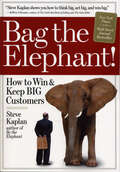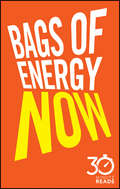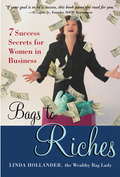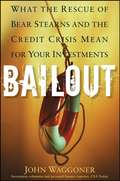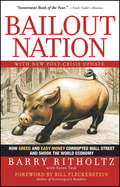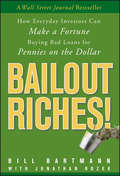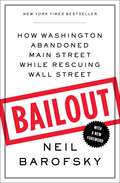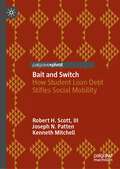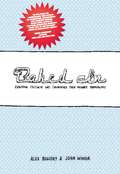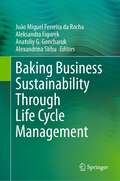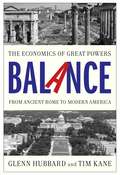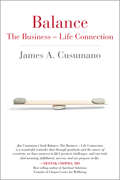- Table View
- List View
Bag the Elephant!: How To Win And Keep Big Customers
by Steve KaplanBag the Elephant is all about how smart businesspeople can woo and keep those all-important elephants—the big, make-or-break customers. Like its companion, the New York Times bestseller Be the Elephant, it is filled with dynamic advice and real-life examples, delivered in an energetic, straight-shooting fashion that gets right to the core of its powerful idea—how to land the account that will put you over the top. <P><P>Here are six keys to achieving the elephant mindset and understanding the big customer. How to map and use a big company's red tape to your advantage. Why the elephant needs you as much as you need it. Preparing yourself and your pitch. How to negotiate with elephants without losing your profit margins. And how to avoid the five killer mistakes, from mismanaging client expectations to losing sight of the numbers. <P><P> For small business owners, entrepreneurs, executives, and sales people, stalking and landing an elephant can be the most profitable adventure of your life, and Kaplan explains everything you need to know.
Bags of Energy Now: 30 Minute Reads
by Nicholas BateYou're half an hour away from the new energized you! Why not use your next spare half an hour to skill-up? Each of these short e-books can be read in just 30 minutes. Addressing those painful work problems, and giving practical tools and expert advice to overcome them, the 30 Minute Reads series will make your work-life more productive, less painful and more successful!If you feel like you are only ever running on empty, and long to be switched on, enthusiastic, engaged and energized every day, this succinct, practical guide will help you blow away the cobwebs, learn how to look after yourself, get your problems into perspective and focus your mind.Also available in a digital bundle with 4 other titles as part of 30 Minute Reads: The business skills collection.Bags of Energy Now will help you:Identify the problem and what isn't workingDiscover the 10 Big StrategiesPut in place your super-structured, super-easy, 5-day count-down plan to no more pain.
Bags to Riches
by Linda HollanderStuck in a dead-end job with mounting debts, Linda Hollander took the biggest risk of her life when she launched a custom packaging business called the Bag Ladies. Working hard and making mistakes along the way, she managed to grow her business into a successful enterprise. Known today as "the Wealthy Bag Lady," Hollander spends her spare time helping other women build self-confidence and achieve financial independence through small-business ownership. In BAGS TO RICHES, Hollander shares her own and other business leaders'¬? advice for getting a small business off the ground, including practical tips for finding a mentor, securing financing, turning contacts into contracts, and providing five-star customer service. More than just your typical "how-to" business book, BAGS TO RICHES explores one of the most difficult aspects of starting your own business-deciding to go for it. Filled with success stories of real-life entrepreneurs, BAGS TO RICHES will inspire women to take that frightening first step to launching a business and realizing a dream.There are currently more than 9.1 million women-owned businesses in America.Women are starting businesses at twice the rate of men.Thanks to Linda Hollander, October has officially been named "Women'¬?s Small Business Month."From the Trade Paperback edition.
Baidu, Alibaba, and Tencent: The Three Kingdoms of the Chinese Internet
by Feng Zhu Aaron SmithThis note provides an overview of the Chinese Internet by describing its leading three companies: Baidu, Alibaba, and Tencent (BAT). While BAT had previously focused their respective businesses on distinct sectors of the online economy-Baidu for search, Alibaba for e-commerce, and Tencent for games and instant messaging-the proliferation of mobile devices in China introduced new territory to be conquered. By the end of 2014, BAT had each made a series of investments and acquisitions to aggressively compete with each other and with other competitors in the emerging mobile space. This note can be used as background for any discussion related to the Chinese Internet industry.
Bailout
by John WaggonerIn Bailout, John Waggoner answers the essential questions surrounding recent market catastrophes--from the failure of Bear Stearns to the credit crisis--and reveals how you can protect your portfolio during these turbulent times. Waggoner offers a wide range of strategies to help your portfolio weather this storm, including rebalancing and using foreign currencies, and discusses how Treasury bonds, gold, commodities, and real estate can solidify your financial standing. With the expert advice found here, you'll quickly discover what it takes to achieve safety and success in today's volatile market.
Bailout Nation: How Greed and Easy Money Corrupted Wall Street and Shook the World Economy
by Barry Ritholtz Bill Fleckenstein Aaron TaskAn engaging look at what led to the financial turmoil we now find ourselves inBailout Nation offers one of the clearest looks at the financial lenders, regulators, and politicians responsible for the financial crisis of 2008. Written by Barry Ritholtz, one of today's most popular economic bloggers and a well-established industry pundit, this book skillfully explores how the United States evolved from a rugged independent nation to a soft Bailout Nation-where financial firms are allowed to self-regulate in good times, but are bailed out by taxpayers in bad times.Entertaining and informative, this book clearly shows you how years of trying to control the economy with easy money has finally caught up with the federal government and how its practice of repeatedly rescuing Wall Street has come back to bite them.The definitive book on the financial crisis of 2008Names the culprits responsible for this tragedy-from financial regulators to politiciansShows how each bailout throughout modern history has impacted what happened in the futureExamines why the consumer/taxpayer is left suffering in an economy of bubbles, bailouts, and possible inflationRitholtz operates a hugely popular blog, www.ritholtz.com/blogScathing, but fair, Bailout Nation is a voice of reason in these uncertain economic times.
Bailout Riches!
by Jonathan Rozek Bill BartmannWhat is the investment opportunity from America's financial crisis? Somewhere north of one trillion dollars of debt--mortgages, credit cards, and other forms--will be written off and sold to buyers at pennies on the dollar. It gets even better: There are ways to buy that debt with no money of your own. Society's collective pain from this crisis means that it's unlikely to occur ever again on this scale. Investors with the right roadmap are poised to profit spectacularly. Bartmann lays out a step by step plan on how to find the best deals from the federal government, local Financial Institutions, and loan brokers. The spectrum of loans that are available include: credit card debt, consumer loans, business loans, commercial loans, and real estate loans. You've heard about the massive government bailout of the financial sector and its cost to taxpayers. Couple that with skyrocketing unemployment and a shrinking stock market and you might think this is a terrible time to invest in anything. But you'd be wrong. In Bailout Riches!, Bill Bartmann shows you how to invest in the bailout itself and take your own cut of the trillion-dollar pie. What does Bartmann know about bailouts? Only that the last big-time government bailout-involving the savings and loan crisis and the government's Resolution Trust Corporation- made him a billionaire. This time around, the bailout is much bigger and opportunities for profit are much greater. "Who better to teach you how to prosper from this economic chaos than a man who actually took himself from 'bankruptcy to billionaire' during the last crisis. "--Ken Blanchard, coauthor, The One Minute Entrepreneur "Bill Bartmann is more than a great financial success story; he is a phenomenal teacher who has helped thousands of my students achieve success. Bailout Riches will show you how you can prosper during these tumultuous times. " --T. Harv Eker, author, New York Times #1 bestseller, Secrets of the Millionaire Mind "When the economy is in crisis, Bill Bartmann finds the diamond in the rough. The information in this book made him a billionaire fourteen years ago during the S&L crisis. Now the economy is cratering again and his methods are working better than ever. Read this book and discover a hidden source of wealth all around you. "--David Lindahl, author of Emerging Real Estate Markets and Multi-Family Millions
Bailout: An Inside Account of How Washington Abandoned Main Street While Rescuing Wall Street
by Neil BarofskyIn this riveting account of the mishandling of the TARP bailout fund, a former federal prosecutor offers behind-the-scenes proof of the corrupt ways Washington officials serve the interests of Wall Street.In this bracing, page-turning account of his stranger-than-fiction baptism into the corrupted ways of Washington, Neil Barofsky offers an irrefutable insider indictment of the mishandling of the $700 billion TARP bailout fund. During the height of the financial crisis in 2008, Barofsky gave up his job in the esteemed US Attorney's Office in New York City to become the special inspector general overseeing the spending of the bailout money. But from day one his efforts to protect against fraud and to hold the big banks accountable were met with outright hostility from Treasury officials. Bailout is a riveting account of Barofsky's plunge into the political meat grinder of Washington, and a vital revelation of just how captured by Wall Street our political system is and why the banks have only become bigger and more dangerous in the wake of the crisis.
Bailout: An Inside Account of How Washington Abandoned Main Street while Rescuing Wall Street
by Neil BarofskyIn this bracing, page-turning account of his stranger-than-fiction baptism into the corrupted ways of Washington, Neil Barofsky offers an irrefutable indictment, from an insider of the Bush and Obama administrations, of the mishandling of the $700 billion TARP bailout fund. In vivid behind-the-scenes detail, he reveals proof of the extreme degree to which our government officials bent over backward to serve the interests of Wall Street firms at the expense of the broader public--and at the expense of effective financial reform. During the height of the financial crisis in 2008, Barofsky gave up his job as a prosecutor in the esteemed U.S. Attorney's Office in New York City, where he had convicted drug kingpins, Wall Street executives, and perpetrators of mortgage fraud, to become the special inspector general in charge of oversight of the spending of the bailout money. From his first day on the job, his efforts to protect against fraud and to hold the big banks accountable for how they spent taxpayer money were met with outright hostility from the Treasury officials in charge of the bailouts. Barofsky discloses how, in serving the interests of the banks, Treasury Secretary Timothy Geithner and his team worked with Wall Street executives to design programs that would funnel vast amounts of taxpayer money to their firms and would have allowed them to game the markets and make huge profits with almost no risk and no accountability, while repeatedly fighting Barofsky's efforts to put the necessary fraud protections in place. His investigations also uncovered abject mismanagement of the bailout of insurance giant AIG and Geithner's decision to allow the payment of millions of dollars in bonuses--including $7,700 to a kitchen worker and $7,000 to a mail room assistant--and that the Obama administration's "TARP czar" lobbied for the executives to retain their high pay. Providing stark details about how, meanwhile, the interests of homeowners and the broader public were betrayed, Barofsky recounts how Geithner and his team steadfastly failed to fix glaring flaws in the Obama administration's homeowner relief program pointed out by Barofsky and other bailout watchdogs, rejecting anti-fraud measures, which unleashed a wave of abuses by mortgage providers against homeowners, even causing some who would not have lost their homes otherwise to go into foreclosure. Ultimately only a small fraction (just $1.4 billion at the time he stepped down) of the $50 billion allocated to help homeowners was spent, while the funds expended to prop up the financial system--as Barofsky discloses--totaled $4.7 trillion. As Barofsky raised the alarm about the bailout failures, he met with obstruction of his investigations, and he recounts in blow-by-blow detail how an increasingly aggressive war was waged against his efforts, with even the White House launching a broadside against him. Bailout is a riveting account of his plunge into the political meat grinder of Washington, as well as a vital revelation of just how captured by Wall Street our political system is and why the too-big-to-fail banks have only become bigger and more dangerous in the wake of the crisis. *** FROM BAILOUT The further we dug into the way TARP was being administered, the more obvious it became that Treasury applied a consistent double standard. In the late fall of 2009, as I began receiving the results of two of our most important audits, the contradiction couldn't have been more glaring. When providing the largest financial institutions with bailout money, Treasury made almost no effort to hold them accountable, and the bounteous terms delivered by the government seemed to border on being corrupt. For those institutions, no effort was spared, with government officials often defending their generosity by kneeling at the altar of the "sanctity of contracts." Meanwhile, an entirely different set of rules applied for home- owners and businesses that were most assuredly small enough to fail. Nowhere was the favoritism toward Wall Street more evident than with the government's ap...
Bailouts: Public Money, Private Profit (A Columbia / SSRC Book (Privatization of Risk))
by Robert WrightToday's financial crisis is the result of dismal failures on the part of regulators, market analysts, and corporate executives. Yet the response of the American government has been to bail out the very institutions and individuals that have wrought such havoc upon the nation. Are such massive bailouts really called for? Can they succeed?Robert E. Wright and his colleagues provide an unbiased history of government bailouts and a frank assessment of their effectiveness. Their book recounts colonial America's struggle to rectify the first dangerous real estate bubble and the British government's counterproductive response. It explains how Alexander Hamilton allowed central banks and other lenders to bail out distressed but sound businesses without rewarding or encouraging the risky ones. And it shows how, in the second half of the twentieth century, governments began to bail out distressed companies, industries, and even entire economies in ways that subsidized risk takers while failing to reinvigorate the economy. By peering into the historical uses of public money to save private profit, this volume suggests better ways to control risk in the future.Additional Columbia / SSRC books on the privatization of risk and its implications for Americans:Health at Risk: America's Ailing Health System--and How to Heal ItEdited by Jacob S. HackerLaid Off, Laid Low: Political and Economic Consequences of Employment InsecurityEdited by Katherine S. NewmanPensions, Social Security, and the Privatization of RiskEdited by Mitchell A. Orenstein
Bain & Co.'s IT Practice (A)
by Andrew McAfeeIn late 2001, the consultancy Bain must decide whether to launch information technology as a practice area within the firm. The senior executives who are Bain's clients have been asking more and more IT-related questions of the firm's partners, who find themselves without good answers. Launching an IT practice, however, will mean acquiring significant amounts of new expertise and incorporating many new partners.
Bain & Co.'s IT Practice (A)
by Andrew McafeeIn late 2001, the consultancy Bain must decide whether to launch information technology as a practice area within the firm. The senior executives who are Bain's clients have been asking more and more IT-related questions of the firm's partners, who find themselves without good answers. Launching an IT practice, however, will mean acquiring significant amounts of new expertise and incorporating many new partners.
Bain & Co., Inc.: Making Partner
by Ashish Nanda Perry L. FaganIn June 1998, Bain's compensation and policy committee meets to review candidates for elevation to partnership. The case presents the profiles of four candidates and ends with the promotion committee debating the merits of the candidates.
Bairong and the Promise of Big Data
by Lauren H. Cohen Xiaoyan Zhang Spencer C. N. HagistBairong CEO Felix Zhang, in launching his credit scoring start-up that incorporates 74,000 variables per individual, found strong initial success. However, the shifting regulatory environment, growing breadth of competitors, difficulties in retaining top talent, and uncertainty around the accumulation and protection of data that fuels the company all threaten the company's stability during its IPO. Defining exactly how his firm will make its mark, and remain indispensable amongst a massive and ever sharpening FinTech landscape, will test Zhang's abilities at the helm and make or break his corner of the industry.
Bait and Switch: How Student Loan Debt Stifles Social Mobility
by Joseph N. Patten Robert H. Scott, III Kenneth MitchellThis book traces how the student loan system has created insurmountable student debt traps for millions of student borrowers contrary to its original purpose of promoting social mobility. Today, approximately 45 million Americans hold over $1.7 trillion in student loan debt, with over 20% of borrowers in default. Student loan debt has the greatest negative impact of wealth-poor students, with Black and first-generation students less likely to attain a college degree, more likely to default on student loan debt, and less likely to gain the same type of wage premium from their college degrees than white student loan borrowers. The book also offers a wide range of policy solutions for remedying the student loan debt crisis.
Bait and Switch: The (Futile) Pursuit of the American Dream
by Barbara EhrenreichAn interesting look at the "midlevel corporate world" and the American middle class.
Bajaj Auto Ltd.
by John A. Quelch Nathalie LaidlerBajaj Auto Ltd., the world's second-largest manufacturer of two- and three-wheeler vehicles, is facing increasing competition in its domestic Indian market. The case evaluates appropriate marketing responses both in the Indian market and export markets.
Bajaj Finance: Building an Omnipresent Financial Services Firm
by Das Narayandas Rachna TahilyaniCase
Bajo el aro: Aprender del éxito y del fracaso
by Pau GasolUn libro que inspira a través del ejemplo y la reflexión. «Nadie dijo que fuera fácil alcanzar tus sueños. Pero si tienes una pasión verdadera y depositas todas tus esperanzas en ella, el esfuerzo para conseguirlos siempre te compensará», afirma Pau Gasol que, en Bajo el aro, comparte con los lectores los valores que le han llevado a lo más alto en su carrera deportiva y su trayectoria personal. No hay nada más bonito que poder desarrollar nuestro talento y hacerlo con pasión. Al hilo de su experiencia a lo largo de una espectacular carrera deportiva, en la que ha obtenido títulos pero también ha perdido finales, ha conocido victorias y derrotas sobre la bocina, ha vivido momentos con una forma excepcional y también la frustración de las lesiones, Pau Gasol comparte en Bajo el aro los principios y valores que le han convertido en un modelo a seguir. En este texto, muy personal, que inspira a través del ejemplo y la reflexión, Gasol aborda cómo el talento, el esfuerzo, el equilibrio o la necesidad de una reinvención permanente pueden aplicarse tanto al liderazgo y al emprendimiento deportivo o empresarial como a nuestro día a día. «Ahora, como cuando era pequeño, la pasión por jugar y por ganar sigue siendo mi motor. Cada día aprecio más lo afortunado que soy por tener el privilegio de amar lo que hago y al mismo tiempo poder inspirar a otros», afirma Paul Gasol compartiendo así su visión con una generosidad y empatía extraordinarias. Reseñas:«Siento un gran respeto por Pau Gasol, sobre todo por haber remontado lesiones graves con estoicismo y haber vuelto con más entusiasmo que nunca para demostrar que lo mejor estaba por venir. Y admiro su calidad humana, su nobleza, su entereza y su bondad, virtudes más grandes que él, ¡que ya es decir!»Plácido Domingo «Talento, esfuerzo, compromiso y, sobre todo, mucha pasión y liderazgo son los valores que Pau Gasol difunde en Bajo el aro. Su capacidad para inspirar y servir de modelo para los jóvenes es digna de elogio, porque el deporte es la puerta de entrada a la salud. Y la salud de los niños y las niñas es garantía de una sociedad futura mejor.»Valentí Fuster «Pau Gasol es un ejemplo para todos los deportistas españoles. Fue un pionero y ha triunfado en un país tan competitivo como Estados Unidos. Y los valores que representa son los que hay que transmitir dentro y fuera de las pistas de tenis o de baloncesto.»Rafa Nadal
Baked In
by Alex Bogusky John WinsorThe old way of selling was to create safe, ordinary products and combine them with mass marketing. The new way is to create truly innovative products and build the marketing right in. But how does a brand make the transition from old to new? According to advertising gurus Alex Bogusky and John Winsor, it starts with the realization that the message is not the product, the product is the message. In Baked-In, they offer a step-by-step guide on how brands can adapt and thrive in this brave new world. Using these tools, Bogusky and Winsor have successfully marketed some of today's most important brands, including Google, Nike, Microsoft, Patagonia, Toyota, and Burger King. They reveal how, through tools at hand - product design, brand history, internal collaboration - and the new tools of digital technology - YouTube and the web in general - companies can succeed in the 21st-century marketplace.
Baker & McKenzie (A): A New Framework for Talent Management
by Boris Groysberg Eliot ShermanDescribes the process by which the largest law firm in the world developed a unique framework for personnel management. In 2004, John Conroy is about to take the reins as the leader of Baker & McKenzie, the largest law firm in the world by employees, with offices in 38 different countries. Facing an intensifying war for talent and associate retention concerns in some offices, Conroy has spearheaded the development of a framework for guiding the hiring, development, and retention of employees. As he is getting ready to introduce his framework at the firm's annual meeting, however, he faces many questions about its implementation. Could a single framework effectively apply to lawyers across so many different regions and cultures? Had this framework properly identified the attributes needed to succeed at Baker & McKenzie? How would the firm's hundreds of partners react? Offers the industry- and firm-specific content necessary for students to explore these questions and more.
Baking Business Sustainability Through Life Cycle Management
by João Miguel Ferreira da Rocha Aleksandra Figurek Anatoliy G. Goncharuk Alexandrina SirbuThis timely and comprehensive text focuses on important recent advances in applied sustainability in the baking industry, connecting all of the current methods and strategies into a single book. Those involved in bread production will find the latest developments at the theoretical and practical levels, including information and communication requirements, reporting and regulatory aspects, economic and environmentally sustainable business models, supply chain management, life cycle assessment, product and organizational environmental footprints and more. For small bakery business owners to industry leaders and policymakers, governmental authorities, regulatory authorities and standardization bodies, this book offers a compilation of technical information about sustainability in the market for the bakery sector. Life Cycle Thinking In Managing Baking Business Sustainability begins by presenting basic information on the life cycle assessment and product environmental footprint of the bread industry, proposing an analysis of sustainability assessment using environmental and social footprints and providing recommendations for integral optimization of economic and environmental performance. A second section focuses on sustainability in the baking industry, providing a regional focus from Europe to The Americas to Africa and beyond. The third section takes a deep look at economic feasibility and efficiency in the bread industry, including an important chapter on the market risk and external shock effects from COVID-19, the economic viability of different scenarios for bread-based value chains, and forming efficient business models for bakeries. A final section zeroes in on the most up-to-date innovations in the current bakery industry, including the impact of bakery innovation on business resilience growth, commercial systems, and new business models in regional food systems for farmers and companies, based on multi-actor approach. Innovations within the bakery industry are at an all-time high, with new sustainability and economic models being introduced, along with associated market risks. This timely and ambitious text aims to cover all of the most recent advances and methods for successful incorporation into bakery businesses.
Balance
by Tim Kane Glenn HubbardIn this groundbreaking book, two economists explain why economic imbalances cause civil collapse--and why America could be next.From the Ming Dynasty to Ottoman Turkey to Imperial Spain, the Great Powers of the world emerged as the greatest economic, political, and military forces of their time--only to collapse into rubble and memory. What is at the root of their demise--and how can America stop this pattern from happening again? A quarter century after Paul Kennedy's Rise and Fall of the Great Powers, Glenn Hubbard and Tim Kane present a bold, sweeping account of why powerful nations and civilizations break down under the heavy burden of economic imbalance. Introducing a profound new measure of economic power, Balance traces the triumphs and mistakes of imperial Britain, the paradox of superstate California, the long collapse of Rome, and the limits of the Japanese model of growth. Most importantly, Hubbard and Kane compare the twenty-first century United States to the empires of old and challenge Americans to address the real problems of our country's dysfunctional fiscal imbalance. Without a new economics and politics of balance, they show the inevitable demise ahead.
Balance
by James A. CusumanoJames Cusumano has led many lives. Implementing his success as an entertainer, scientist, corporate executive, and entrepreneur as a template, Cusumano shares his multifaceted guide to success, personal fulfillment, and balance. This easy-to-follow, autobiographical guidebook, Balance: The BusinessOCoLife Connection, instructs readers in methods whic"
Balance Sheet
by Jacob Cohen David F. HawkinsDiscusses the accounting equation and defines common terms found in the statement. Also provides an example of the balance sheets of Coca-Cola Co., Ariba, Inc., and Safeway, Inc.
